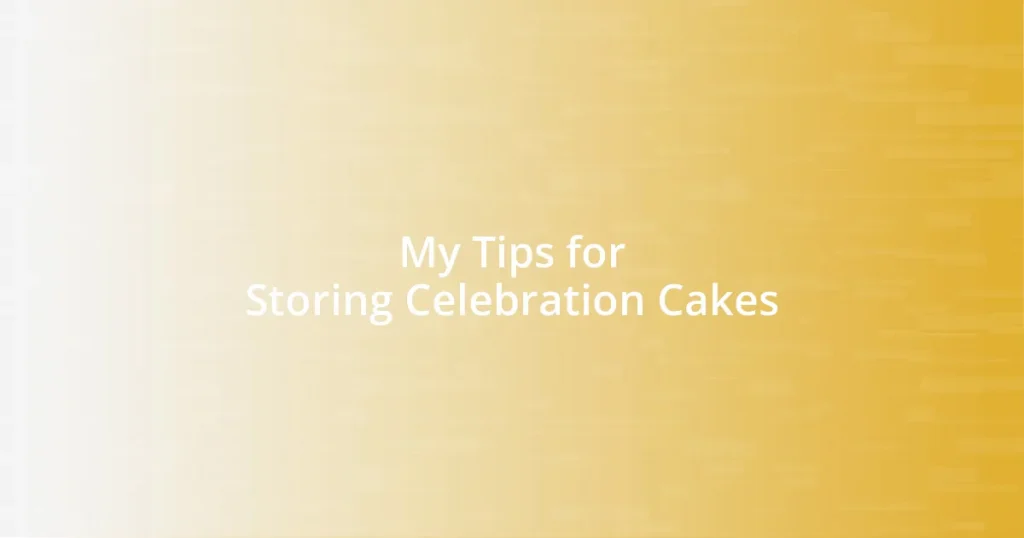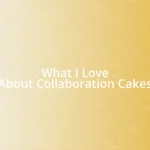Key takeaways:
- Using airtight containers and proper temperature is crucial for storing celebration cakes to maintain freshness and prevent odors.
- Wrapping cakes with plastic wrap and aluminum foil extends shelf life; double wrapping provides extra protection against drying out.
- Thawing cakes slowly in the fridge and keeping them wrapped ensures moisture retention and better texture.
- Reviving dry surfaces with simple syrup before decorating enhances adhesion of frosting and improves presentation.

Understanding Celebration Cake Storage
When it comes to storing celebration cakes, it’s essential to consider the type of cake and its toppings. I remember a time I stored a delicate whipped cream cake in the fridge, only to find it had absorbed the flavors of the fridge—definitely a rookie mistake! This experience taught me that while refrigeration is important for freshness, it’s equally crucial to use airtight containers to protect the cake from moisture and other odors.
One factor that often gets overlooked is the importance of temperature. I once had a beautifully decorated fondant cake that I naively placed in a warm kitchen for a few hours. The fondant melted slightly, causing some of the intricate designs to run. Isn’t it interesting how we often overlook the simplest things? Keeping cakes in a cool, dry place, away from direct sunlight, can significantly extend their shelf life and preserve their beauty.
Also, don’t underestimate the power of wrapping! I’ve found that using plastic wrap or aluminum foil can keep cakes fresher for longer periods. Just picture that moment when you cut into a cake, and the first slice falls apart because it dried out—such a letdown! Taking the time to wrap your cake properly not only protects its texture but also shows the care and love you have for your creation.

Best Containers for Cake Storage
When it comes to storing celebration cakes, the right container can make all the difference. I remember choosing a beautifully designed cake carrier for my sister’s birthday cake; it not only looked great but also helped preserve the cake’s moisture. The key is to find a container that is both airtight and spacious enough to accommodate the cake without squishing the decorations.
Here are some of the best container options for storing your beloved cakes:
- Cake Domes: Perfect for showcasing the cake while keeping it fresh. I love how they create a mini scene in my kitchen—like a cake museum!
- Airtight Cake Carriers: They come with handles for easy transport, making them great for potlucks or parties. I’ve used one for holiday gatherings, and it was a lifesaver!
- Plastic Wrap with Cardboard: For short-term storage, wrapping the cake in plastic wrap and placing it on a cardboard base is effective. I once used this method, and my cake stayed soft and delightful for days.
- Glass Cloche: Adds a touch of elegance while providing adequate protection. I usually display my cakes under one, and it even serves as a decorative piece in my dining room.
- Foil Containers for Freezing: If you need to freeze pieces of cake, these are sturdy and keep the cake safe from freezer burn. I often do this after events to extend the enjoyment of a celebration cake.

How to Properly Wrap Cakes
When you wrap a cake, the material you choose plays a crucial role in maintaining its freshness. I often find myself reaching for plastic wrap, as it clings tightly and helps prevent air from sneaking in. Remember that double-wrapping can provide that extra layer of protection; I learned this the hard way when a single layer of foil couldn’t keep my lemon cake from drying out.
It’s also important to consider the wrapping technique. I once wrapped a cake without properly sealing the edges and ended up with a cake that had absorbed the fridge’s smells—what a disaster! Tightly sealing your cake ensures that it remains protected from other strong odors or unwanted flavors, maintaining the delicate balance of taste and freshness.
In my experience, it’s beneficial to label your wrapped cakes with the date of storage. This little practice has saved me from digging into a cake and wondering how long it’s been sitting there. Being organized helps keep track of freshness and ensures that you enjoy your delicious creation at its best!
| Material | Pros |
|---|---|
| Plastic Wrap | Tightly seals the cake, prevents air exposure, and keeps moisture in. |
| Aluminum Foil | Offers durability and protection against external elements but may need double-wrapping for best results. |
| Wax Paper | Useful for cakes with icing as it won’t stick, though it isn’t as airtight as plastic wrap. |
| Parchment Paper | Great for short-term storage, especially for cakes that are being decorated, but lacks moisture retention. |

Refrigeration Tips for Celebration Cakes
When it comes to refrigerating celebration cakes, I always keep in mind that a perfect chill temperature is key. Ideally, you want your fridge set between 34°F and 40°F (1°C to 4°C) to preserve the cake’s taste and texture. I remember the time I stored a delicate red velvet cake too close to the back of the fridge— the cold air dried it out. Have you ever had a cake that felt cold but lost that luscious softness? That experience taught me to position my cakes a bit farther from the cooling vents.
Another tip I’ve learned is to avoid placing the cake near strong-smelling foods. Refrigerators are like those tiny apartments that often end up with all kinds of scents wafting around. I once stored a beautiful vanilla cake next to a bowl of leftover curry, and it was a total flavor disaster. Can you imagine biting into a slice of cake that tasted like dinner? It’s an experience I’ll never forget, and now I always check my fridge’s layout before storing cakes.
Lastly, if your cake has any decorations, consider a light covering with a paper towel before sealing it in an airtight container. This little trick creates a barrier to any unwanted condensation while still allowing for some airflow. I recall how this saved my fondant decorations from becoming a soggy mess after a night in the fridge. Have you ever had a cake that looked beautiful but was a sticky, gooey disaster on the inside? I think we can agree that’s a heartbreaker, and with these tips, we can avoid those cake heartbreaks together!

Freezing Cakes for Long-Term Storage
If you’re looking to freeze a cake for long-term storage, timing is everything. I’ve found that it’s best to freeze cakes when they are completely cool to avoid condensation forming inside the wrapping. One time, I was impatient and froze a warm chocolate cake; it turned into a soggy sponge upon thawing. Have you ever wondered why some cakes lose their structure after freezing? That’s usually due to moisture getting trapped during the freezing process.
When wrapping a cake for the freezer, I always opt for multiple layers of plastic wrap, followed by a layer of aluminum foil. It might sound excessive, but I once forgot this step and paid the price—my cake picked up some strange flavors that I can only describe as “freezer burn.” Although it was an odd flavor experience, it was a lesson learned: double protection keeps the deliciousness intact!
Thawing your frozen cake is equally crucial. I always let my cake thaw slowly in the fridge overnight to preserve its moisture. Rushing this process leads to dry cake—another lesson I learned the hard way! Have you ever cut into a cake only to find it crumbling apart? A little patience goes a long way in maintaining that perfect texture. Remember, slow and steady wins the cake!

Thawing Cakes Safely
Thawing a cake properly is a game-changer for flavor and texture. I always recommend taking it out of the freezer and letting it thaw in the fridge overnight. One time, I was in a rush and decided to speed things up by placing my cake on the counter. The result? A dry, crumbly disappointment that left me questioning my baking skills. Have you ever experienced that kind of letdown? It’s hard to watch a labor of love turn into a mere shadow of its former self.
I also find that keeping the cake wrapped during thawing is essential. Once, while chatting with a friend, I left my carrot cake unwrapped for a couple of hours after thawing it in the fridge. When I went to serve it, the edges were dried out and unappetizing. Have you ever noticed how sometimes it’s the small mistakes that haunt us the most? That’s why now I always keep the wrapping on until I’m ready to slice and serve. This little tip makes a world of difference in keeping that moisture locked in.
Lastly, I’ve learned that allowing the cake to come to room temperature before serving really elevates the experience. A few months back, I served a thawed lemon cake straight from the fridge without waiting. As my guests took their first bites, they seemed puzzled by the chilled flavor. That awkward moment taught me the importance of letting cakes rest outside the fridge for about 30 minutes. Don’t you agree that a cake should taste as inviting as it looks? Trust me, the wait is worth it for that perfect slice!

Decorating Cakes After Storage
When it comes to decorating a cake after it’s been stored, I approach it with a delicate touch. The surface of the cake can sometimes get a bit dry during storage, so I always start with a thin layer of simple syrup to revive that moisture. I learned this the hard way when I once tried to frost an older chocolate cake that ended up looking more like a desert than a dessert. Have you experienced that frustrating moment when your icing just doesn’t stick? A little syrup can work wonders in making sure your frosting glides on smoothly.
Once I’ve brought the cake back to life with a glaze of syrup, I dive into the decorating. I tend to keep it simple yet elegant, often choosing fresh fruit or edible flowers to bring that bit of freshness to the look. I vividly remember decorating a white cake for a friend’s birthday, topping it with vibrant strawberries and mint leaves. The way the colors popped against the white frosting was stunning, and it felt rewarding to see my friend’s eyes light up when she saw it. What do you think makes a cake truly stand out for you—simple elegance or extravagant flair?
Additionally, timing plays a crucial role in how well the decorations hold up. I make sure to frost and decorate the cake close to serving time to avoid any melting or sogginess. I once decorated a lovely vanilla cake a few hours too early and, by the time it was served, the frosting had started to slide off. It was disheartening to see all the effort I’d put in go to waste. Have you ever had a beautifully decorated cake fall apart before your eyes? It’s moments like those that remind me the best decorations are enjoyed in their prime!















